Forum Replies Created
-
AuthorPosts
-
PopeyeTheTrailerMan
ParticipantFWIW, on CLC kayaks I’ve built I’ve attached the same foam that is used for the Teardrop headliner directly to unvarnished epoxy using contact cement. The space regularly gets filled with water, though not for more than a few hours at a time. After 14 years, no problems.
Just make sure that the epoxy is completely cured before applying the contact cement.
PopeyeTheTrailerMan
ParticipantI have the CLC recommended mattress. Both my wife and I find it very comfortable. It does need some kind of sheet, sleeping bag or other bedclothes, though, because the bare mattress surface is not pleasant to lie on, especially where it contacts bare skin.
PopeyeTheTrailerMan
ParticipantPopeyeTheTrailerMan
ParticipantFor timing, I installed my solar power system after the camper was completely done. It already had the complete CLC electrical package installed. The solar panels and circuitry were all new additions, along with the replacement 100 AH LiFePO battery.
The panels and charge controller were from Komaes Solar, their dual 100 watt 12-volt panels wired in parallel for a total of 200 watts at 12 volts. The battery was from Battle Born. I’ve got a post showing the installation here. With 200 watts I can put power in faster than I take it out, even on an overcast day.
FWIW, ever since I’ve installed the solar power system and 100 AH battery, I have never needed to hook up to shore power. The solar power is enough to keep it charged. However, I am using an ice chest instead of a fridge.
PopeyeTheTrailerMan
ParticipantI bought the Battleborn off Amazon for $900. Yes, that’s a big chunk of money, but it’s been worth every penny and it’s actually cheaper than a lead acid battery over the long term.
A 100 AH lead acid does not produce the full rated power over the entire charge. As it discharges it produces less power. So the lithium battery actually is the equivalent of a significantly larger lead acid. Lithium batteries also last much longer than lead acids. During the 10-year warranty period of the lithium battery, you’ll probably replace the lead acid at least once, probably twice.
As glcmranger mentions, the battery management system is very important. The one for the Battleborn makes it act like an ideal lead acid. The input and output voltage ranges match in both batteries. The lithium can be short circuited without damage because the bms will shut the outputs down. It can’t be overcharged because the bms will shut the inputs down if the voltage or current is too high. The bms also shuts down if the battery gets too hot. Basically, the bms protects against all the problems that tend to kill lead acid batteries early.
As a result of all this, over the guaranteed lithium lifetime it’s less than 1/3 the cost of the equivalent AH rated lead acid battery. If you can afford the upfront cost, you’ll actually come out cheaper with a lithium battery. And while $900 is a good sized chunk all at once, spread out over a year it’s less than $2.50 per day.
I’ve been really happy with mine. It’s made my camping experience much better than it was with the lead acid, especially with the solar panels to charge it.
PopeyeTheTrailerMan
ParticipantNot sure if an extra layer of glass would stiffen it enough. You probably need carbon fiber with the threads oriented to align against the maximum warp. Alternatively, wooden gussets to keep the hatch from changing shape would also work, but they could interfere with things inside the galley. That’s why I went with the straps – they seemed the most cost-effective and easiest to install and use.
If you used leather, you could have that classic car look 🙂
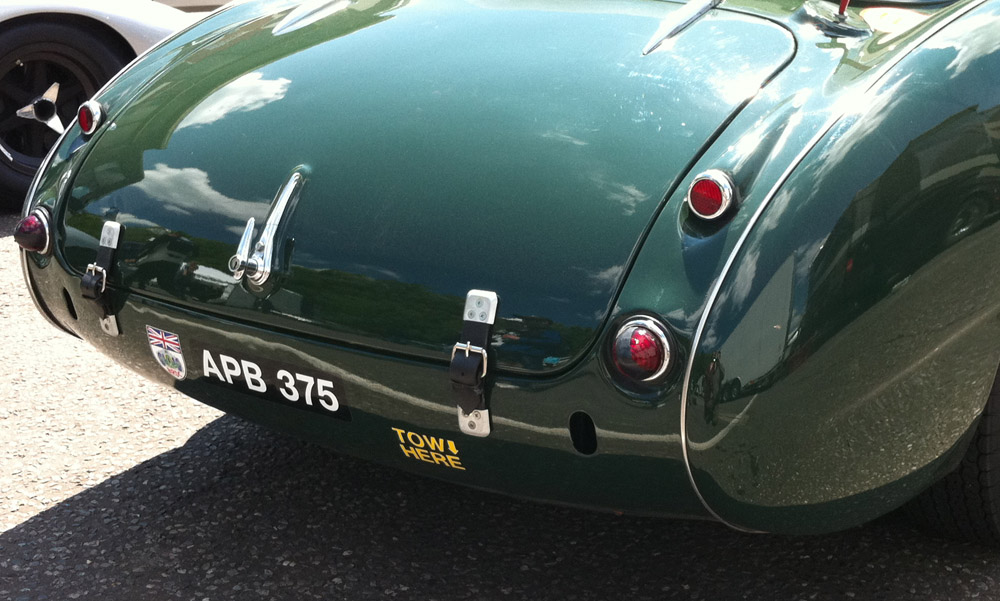
PopeyeTheTrailerMan
ParticipantThat looks as if you got a bad sheet of wood. I’d bring that to the supplier’s attention and get a replacement. BS-1088 is very definitely not supposed to do that.
PopeyeTheTrailerMan
ParticipantI bought AAA RV insurance (it’s through Geico). It covers the cost of the camper and gear (like the lithium battery and solar cells, sleeping bags, cookware, etc.) that’s in the camper at the time of the accident up to a pre-agreed on amount.
While I was at it, I upgraded my AAA plan to include road service and towing for the camper, as well as our vehicles.
PopeyeTheTrailerMan
ParticipantThe classes are pitched to having something you can tow home at the end of the 2 weeks. CLC does a bunch of prep work for you, the instructor keeps you focused and spots (and fixes) problems before they get out of hand. There’s plenty of workspace, complete with all the tools and supplies you could need. The classes also require that you have a partner. Finally, you are isolated in the shop for 2 weeks with no distractions (jobs, lawns, in-laws, etc.). All this means that the classes are pretty much the ideal situation and very different than most solo home builds. Don’t expect the home build time to be anywhere near as efficient as the class build time. It will take longer, and that’s OK.
The thing with a fast assembly, though, is that it tends to increase the finish time, especially for people doing their first builds. Usually, a slower assembly results in a faster finish. Taking the time to avoid drips, make sure that the alignments are correct, etc. means less clean-up with a sander at the end.
All this to say – don’t worry about the time. It will take as long as it takes. The most important thing is to do something, anything, every day. If you can’t be cutting wood, stitching/tabbing, gluing or wetting out glass, be planning the electrical system, working out the interior layout, researching insurance quotes, etc. Tools always need sharpening and cleaning (especially those scissors – mine are still going strong after 10 years), expendables (gloves, sandpaper, etc.) always need inventory and restocking. Clean the shop when you don’t have time or energy to glue more parts on or if you’re too tired to cut a straight line. If everything else is done, sit in the shop and websurf to find campgrounds to visit.
By being in the shop every day and doing something, no matter how small, to advance the project, you will maintain the momentum and get it built faster. The builds that take a long time (or never get finished) are the ones that get ignored. They turn into expensive guilt-trips that people end up trying to avoid, which makes things even worse.
Slow but steady wins the race.
PopeyeTheTrailerMan
ParticipantI got it from CLC, not directly from Thule. It’s the CLC Roof Rack Package. It has custom mounting blocks (pictured in the link) that through-bolt to the roof. They simulate a car’s rain gutters and allow the Thule towers to clamp on just as for an automobile. I believe they’re only available (the bases) from CLC.
PopeyeTheTrailerMan
ParticipantHere’s a variation on your internal lock idea. I liked the simplicity of your concept, but it seemed to me that the mechanics could be improved a bit. The main thing was to attach the straps to the door frame, rather than the shelf. This improves the mechanical advantage and pretty much guarantees that the loop will never accidentally slip off. The other thing was to use a stitched loop to avoid having a loose piece of metal flailing around.
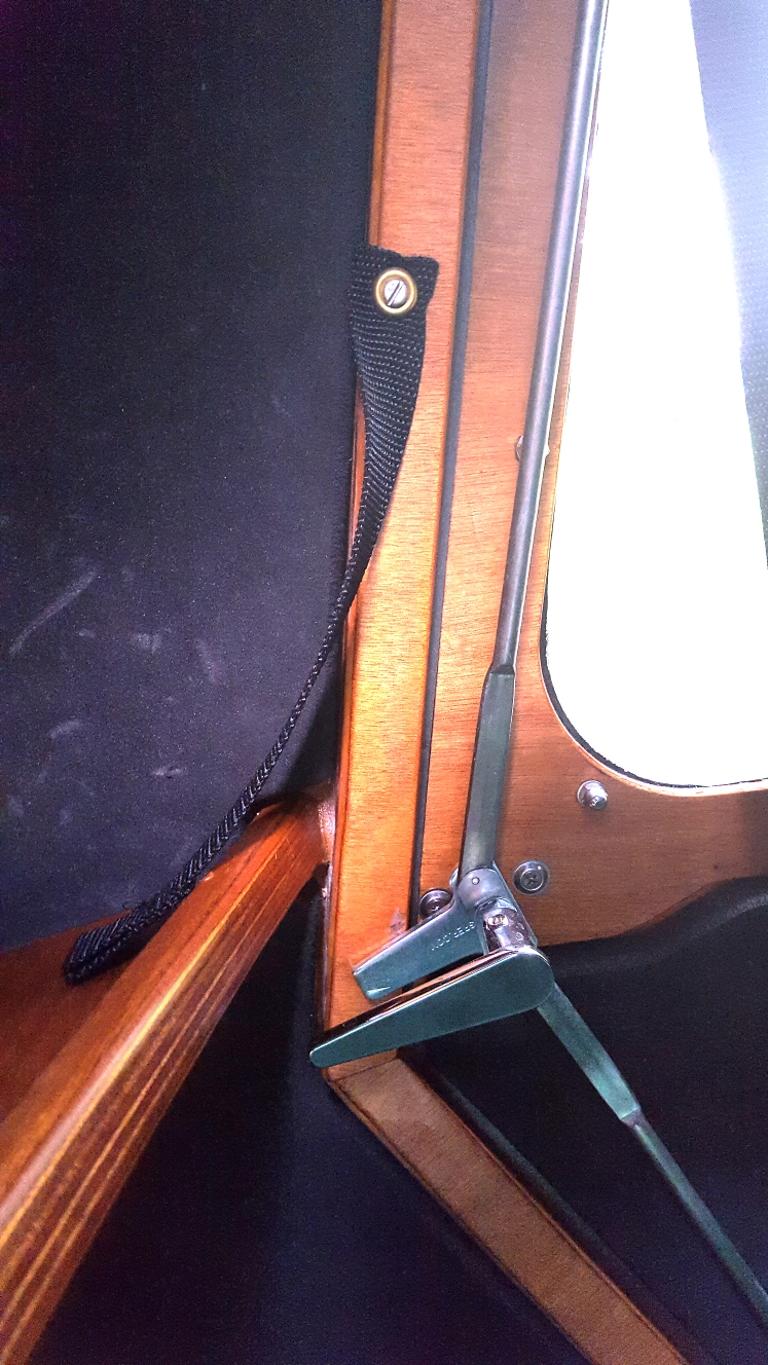
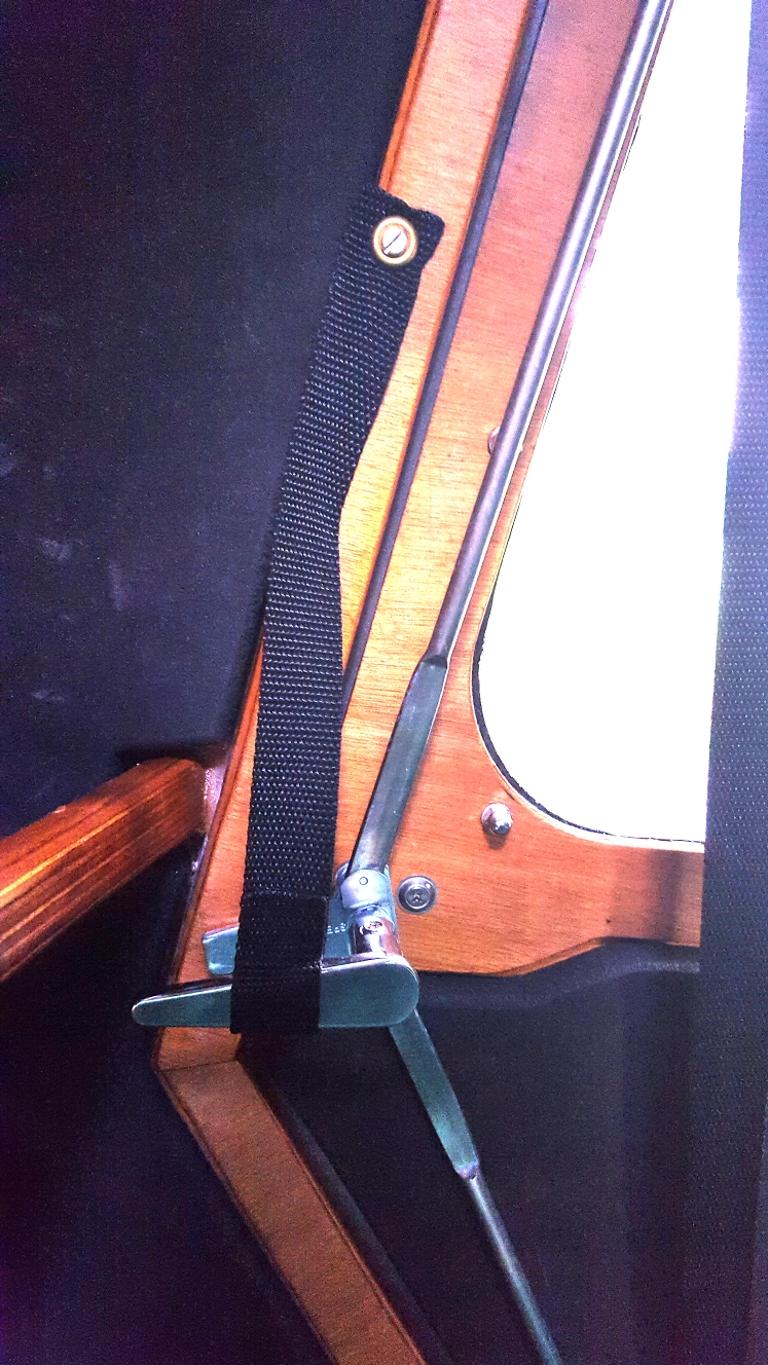
I did have to be careful when attaching the strap to make sure that the screw was in the thick part of the door frame, instead of the sill.
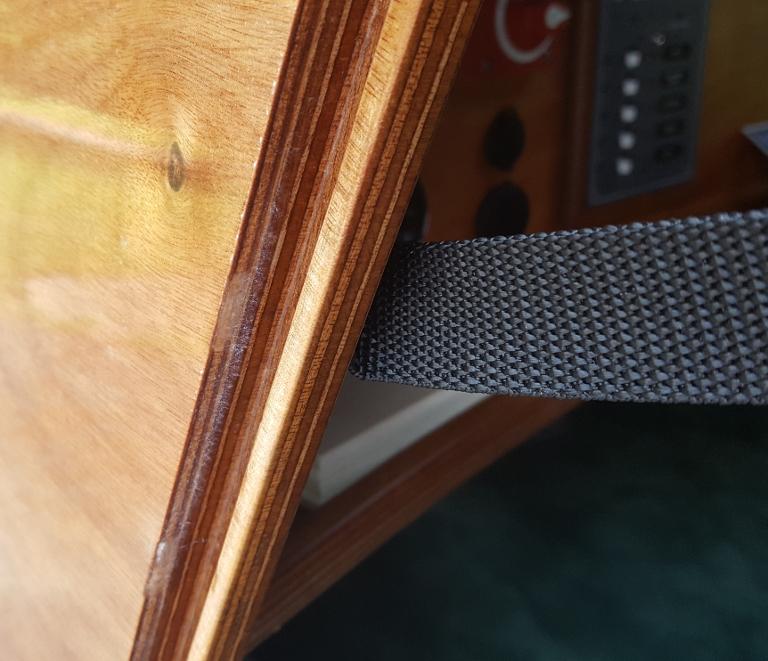
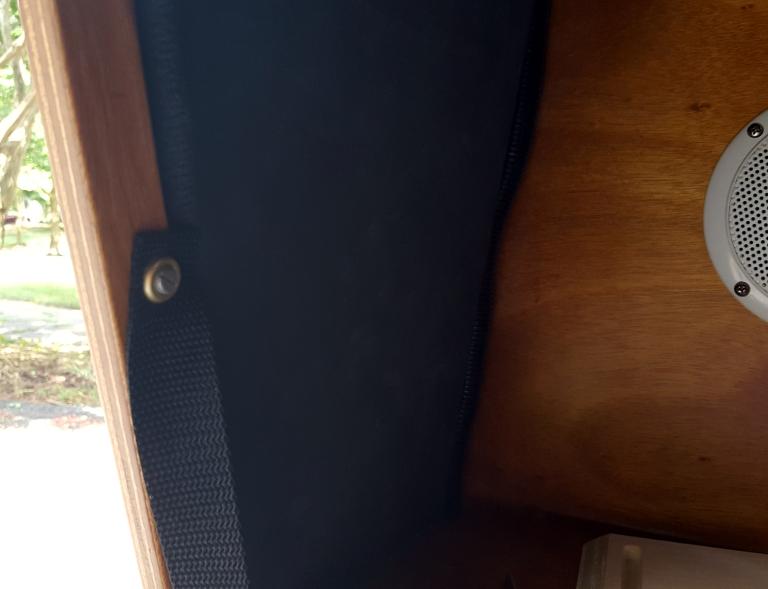
Thanks for the idea.
PopeyeTheTrailerMan
ParticipantHi faithie,
Sorry I was away from computer and didn’t see your message til today. Yes, I did mount them on top, on the Thule racks. I got the wider load bars so that I could put one panel on each side and still have room for the fan cover to open and to have a bit of bar left for potentially adding awnings and such.
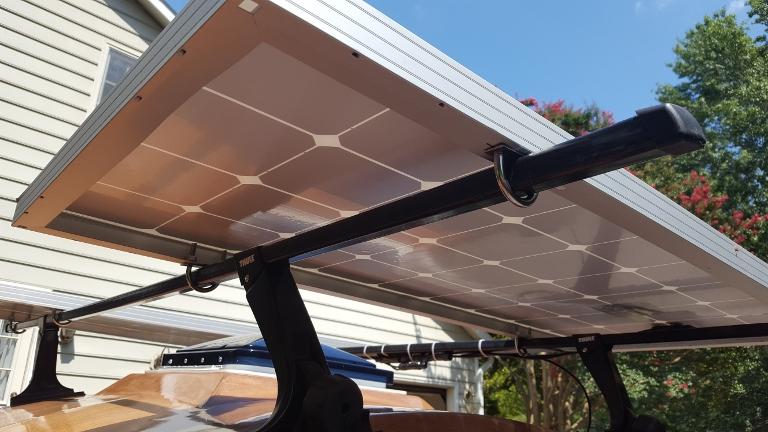
I mounted the panels to the bars using stainless steel u-bolts from Home depot. The size depends on the load bars. I had to drill holes in the panel frames since the existing holes did not match up with the load bar spacing. Be sure that the panels are far enough forward to allow the galley lid to open all the way without interference.
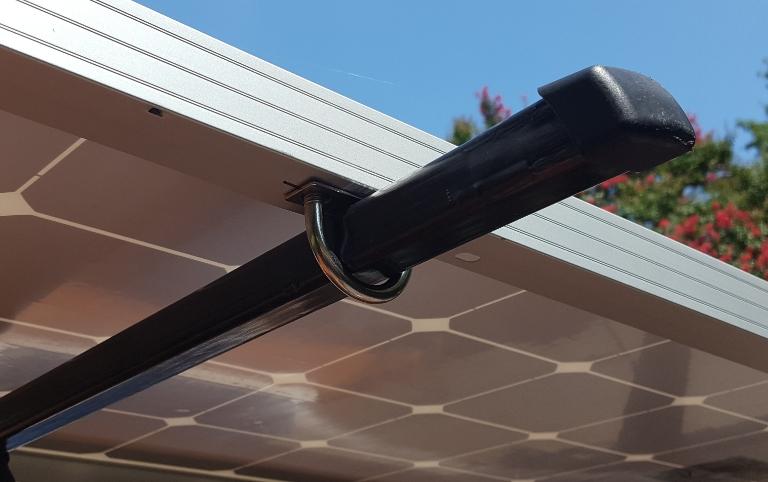
The wiring is zip-tied to the rear bar. One day I’ll add a low drag cover, but for now it’s OK as-is since the cables and connectors are weather-proof.
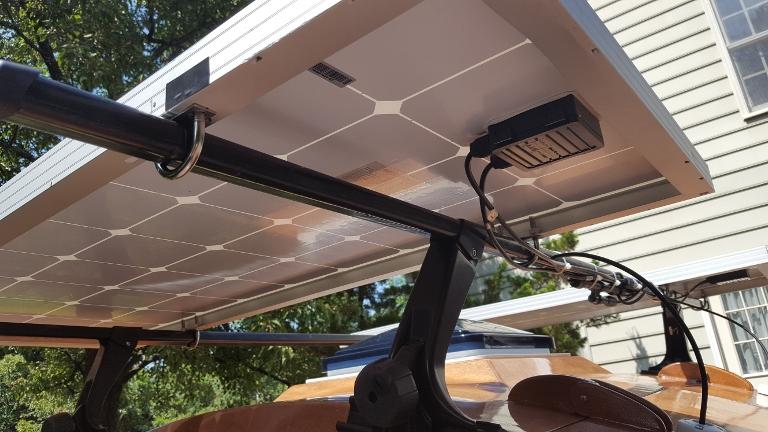
The panels are wired in parallel to give a nominal 12v at 200 watts max. The actual voltage can be over 20 volts on a bright sunny day. A single positive (left) and negative (right) lead go down to the controller that is mounted in the galley.
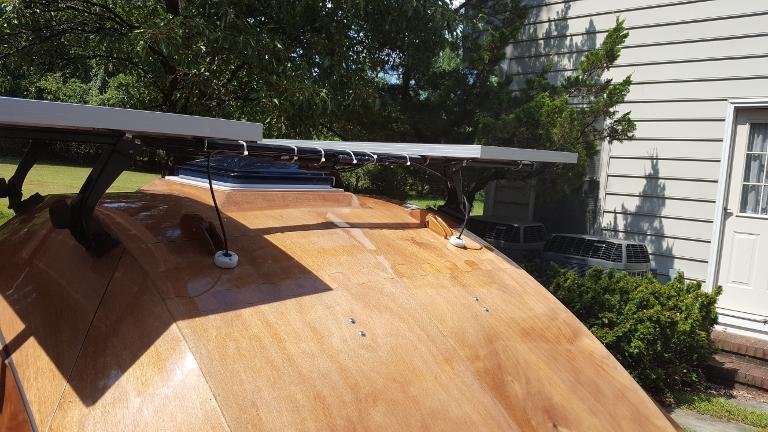
The wires each go through a CableClam (available from CLC) which allows a leak-proof passage through the galley lid.
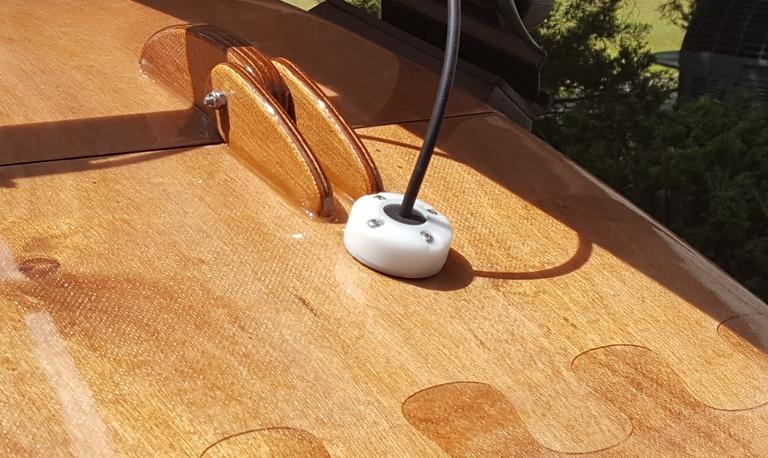
The wires end up in the solar controller, which is wired directly to the battery (through a fuse) parallel to the shore power controller.
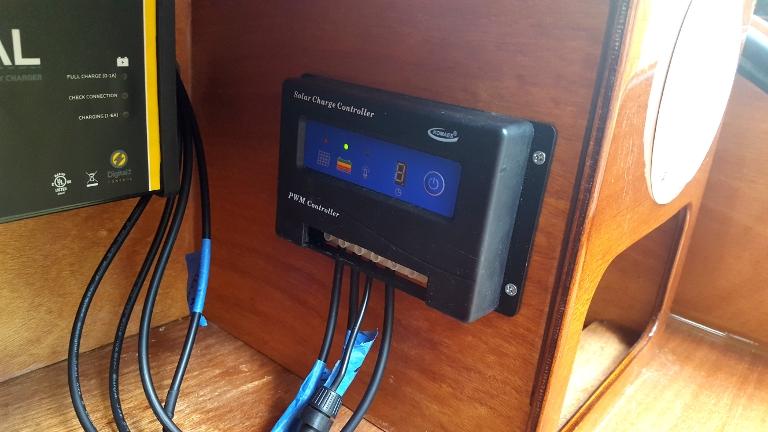
Let me know if you need more info or pictures.
PopeyeTheTrailerMan
ParticipantI know that this is an old thread, but earlier this year I got tired of all the BS with lead acid batteries and sprung for a 100 AH LiFePO battery. As everyone noted, it’s expensive up front. However, in just a few years it will have more than paid for itself by outlasting lead acids, even sealed AGM, as well as cheaper camping costs.
So how’s it working?
My camper has a 200-watt solar charger system that was $200 new on Amazon (pre-Trump tariffs). I wired it in parallel with the existing charger to the battery. Before the LiFePO I was always worried about how long the battery would last before being drained by the fans, lights, etc. Since I’ve installed the new battery I’ve never had to worry. During the day, even if it’s cloudy, the solar panels are putting in more than the full load can drain. Running the ceiling fan all night, along with occasionally running other fans, lights and recharging my tablet has yet to bring the indicated voltage below 13.1. It has been literally months since I last plugged into the mains.
Since the power is now so reliable, I routinely camp in primitive areas with no hookups. I’ve been saving at least $20/night at commercial campgrounds that way. If I do that for 50 nights, that’s enough tp pay for the LiFePO battery right there, never mind the longevity and replacement comparisons.
This battery has an electronic controller that handles shorts, overvoltage, overcurrent, etc. It shuts off inputs and outputs when needed to protect the battery. Basically, between the controller and the chemistry, it makes it act like an ideal battery that you can hook up to existing 12v lead acid charger and load systems and forget about. The amp-hour calculations are honest and straightforward – 100 amps for 1 hour, 5 amps for 20.
The controller makes it play well with existing lead acid systems. With those, it takes about 16 hours to fill a totally drained battery. But if you get special chargers you can fill it in 1/2 hour or so. I didn’t bother since the solar panels are continuously refilling it. In the garage, away from the sun, it holds its charge without being hooked to a charger, without being damaged the way a lead acid battery would be.
The lightness is also remarkable. I struggled to remove the existing lead acid battery with 2 hands. I easily installed the LiFePO with one. It was a bit too big to fit in the battery box, but since it doesn’t have acid in it and is completely sealed, I ditched the box and just wedged the battery in place with foam.
So the short answer is – I’m using a 12v lithium battery and I couldn’t be happier with it. If you can afford to put $4 a day for a year into your piggy bank, at the end of that year you can have a battery that will pay you back after 2 months of camping, then pay you back again at least 4 more times in the extra lifetime over lead acid batteries. You’ll also have the peace of mind of a reliable power system. Don’t wait, start saving your change.
PopeyeTheTrailerMan
ParticipantI stand in awe of the master.
PopeyeTheTrailerMan
ParticipantA pair of customer-owned Teardrops showed up at Okoumefest last week. The one with the solar panels camped there Friday night, the one with the awning arrived for the show-and-tell on Saturday.
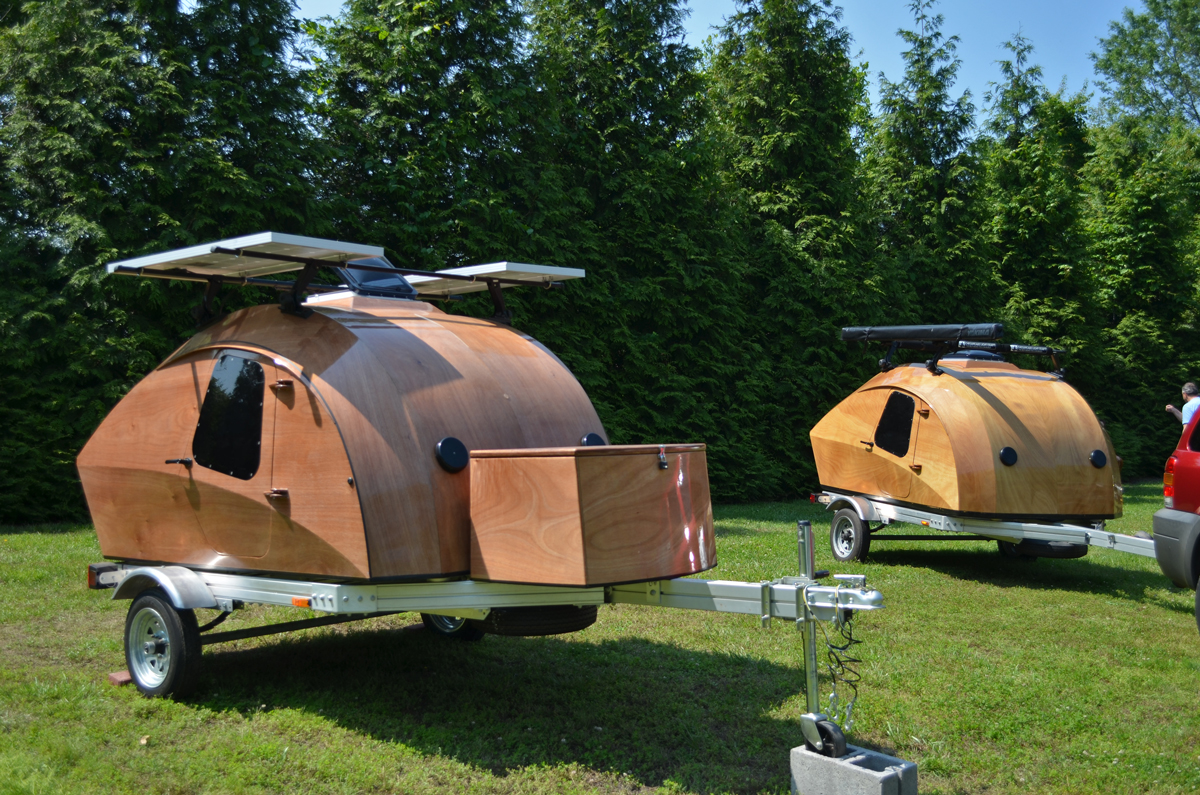
-
This reply was modified 4 years, 11 months ago by
PopeyeTheTrailerMan.
-
This reply was modified 4 years, 11 months ago by
PopeyeTheTrailerMan.
-
This reply was modified 4 years, 11 months ago by
-
AuthorPosts